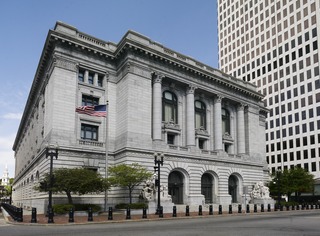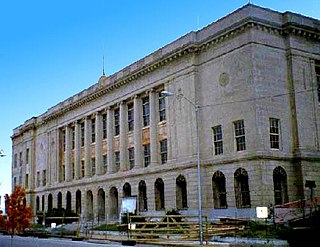
The James R. Browning U.S. Court of Appeals Building is a historic post office and courthouse building located at San Francisco, California. It is a courthouse for the United States Court of Appeals for the Ninth Circuit. Completed in 1905 as the U.S. Courthouse and Post Office, it was intended to represent the affluence and increasing importance of the United States as it became a world power. The building survived both the 1906 San Francisco earthquake and the 1989 Loma Prieta earthquake.

The Spring Street Courthouse, formerly the United States Court House in Downtown Los Angeles, is a Moderne style building that originally served as both a post office and a courthouse. The building was designed by Gilbert Stanley Underwood and Louis A. Simon, and construction was completed in 1940. It formerly housed federal courts but is now used by Los Angeles Superior Court.

The U.S. Customhouse is a historic custom house located in San Francisco, California. It was built to house offices of the United States Customs Service.

The William R. Cotter Federal Building is a historic post office, courthouse, and federal office building located at 135–149 High Street in Hartford, Connecticut. It was the courthouse for United States District Court for the District of Connecticut until 1963.

The William Augustus Bootle Federal Building and U.S. Courthouse, also and formerly known as Old U.S. Post Office and Federal Building, is a courthouse in Macon, Georgia of the United States District Court for the Middle District of Georgia. Completed in 1908, it initially served as a courthouse of the United States District Court for the Southern District of Georgia, until the creation of the Middle District in 1926. It was individually listed on the National Register of Historic Places (NRHP) in 1972 as "Old U.S. Post Office and Federal Building", and also is included in the NRHP-listed Macon Historic District. It was renamed in honor of district court judge William Augustus Bootle in 1998.

The Elbert P. Tuttle U.S. Court of Appeals Building, also known as U.S. Post Office and Courthouse, is a historic Renaissance Revival style courthouse located in the Fairlie-Poplar district of Downtown Atlanta in Fulton County, Georgia. It is the courthouse for the United States Court of Appeals for the Eleventh Circuit.

The United States Courthouse, also known as the Federal Building, is a historic building located in Davenport, Iowa, United States. It has historically housed a post office, courthouse, and other offices of the United States government. The building now serves only as a federal courthouse, housing operations of the eastern division of the United States District Court for the Southern District of Iowa. In 2018, the operations of the Rock Island division of the United States District Court for the Central District of Illinois were also moved there.

The U.S. Courthouse, Wichita, Kansas is a historic post office, courthouse, and Federal office building located at Wichita in Sedgwick County, Kansas. It is a courthouse for the United States District Court for the District of Kansas.

The Gene Snyder U.S. Courthouse and Custom House, also known as United States Post Office, Court House and Custom House, is a historic courthouse, custom house, and post office located at Louisville in Jefferson County, Kentucky. It is the courthouse for the United States District Court for the Western District of Kentucky. It is listed on the National Register of Historic Places under the "United States Post Office, Court House and Custom House" name.

The Federal Building and U.S. Post Office, Spokane, Washington is a historic post office, courthouse, and custom house building at Spokane in Spokane County, Washington. It is a courthouse for the United States District Court for the Eastern District of Washington.

The James T. Foley United States Courthouse is a stone Art Deco federal courthouse, located on Broadway in downtown Albany, New York, United States. Built in the 1930s, it was included in 1980 as a contributing property when the Downtown Albany Historic District was listed on the National Register of Historic Places. In 2020 it was listed on the Register individually as the United States Post Office, Court House, and Custom House.

The Joel W. Solomon Federal Building and United States Courthouse, commonly referred to as the Solomon Building, is a historic post office and courthouse located at Chattanooga, Tennessee in Hamilton County, Tennessee. The courthouse serves the United States District Court for the Eastern District of Tennessee. The building is listed on the National Register of Historic Places as U.S. Post Office. It was designed by Shreve, Lamb and Harmon and Reuben Harrison Hunt with watercolor murals by Hilton Leech.

The Howard M. Metzenbaum U.S. Courthouse is a historic courthouse and post office building located on Superior Avenue in downtown Cleveland, Cuyahoga County, Ohio. Its west side faces Public Square and its north side faces The Mall. It was formerly the Federal Building and U.S. Courthouse and also known as Old Federal Building and Post Office.

The Ronald N. Davies Federal Building and U.S. Courthouse is a historic post office and federal office building located at Grand Forks in Grand Forks County, North Dakota, United States. It is a courthouse for the United States District Court for the District of North Dakota. Also and historically known as U.S. Post Office and Courthouse, the building is listed on the National Register of Historic Places under that name.

The United States Post Office and Courthouse, Oklahoma City, Oklahoma is a historic post office, courthouse, and Federal office building built in 1912 and located at Oklahoma City in Oklahoma County, Oklahoma. It previously served as a courthouse of the United States District Court for the Western District of Oklahoma, and of the United States Court of Appeals, briefly housing the Eighth Circuit and, then the Tenth Circuit for several decades. It was listed on the National Register of Historic Places in 1974. It continues to house the Bankruptcy court for the Western District of Oklahoma. The building includes Moderne and Beaux Arts.

The Federal Building is a historic post office, courthouse and custom house on Kennedy Plaza in downtown Providence, Rhode Island. It is a courthouse for the United States District Court for the District of Rhode Island. It was built in 1908 by Clarke & Howe of limestone and steel and has a courtyard in the center.

The Joseph F. Weis, Jr. U.S. Courthouse is a Beaux Arts-style building in Pittsburgh, Pennsylvania, US. It is a courthouse for the Western District of Pennsylvania, a United States district court. Until 2015, the building was known as the US Post Office and Courthouse-Pittsburgh.

The David W. Dyer Federal Building and U.S. Courthouse, formerly known simply as the U.S. Post Office and Courthouse, is an historic United States Post Office and federal courthouse of the United States District Court for the Southern District of Florida located at 300 Northeast 1st Avenue in Miami, Florida. Built in 1931 of limestone, it is the largest such structure in South Florida.

The Byron White United States Courthouse is a courthouse in Denver, Colorado, currently the seat of the United States Court of Appeals for the Tenth Circuit. It formerly housed courthouses of the United States District Court for the District of Colorado. Completed between 1910 and 1916, the building was listed in the National Register of Historic Places in 1973, as U.S. Post Office and Federal Building. In 1994, it was renamed in honor of U.S. Supreme Court Justice Byron White (1917–2002) a native of Fort Collins, Colorado.

The Ed Edmondson United States Courthouse, previously called the Muskogee Federal Building- United States Courthouse, is a historic government building in Muskogee, Oklahoma. It was built in 1915 as a post office and federal courthouse. Although it is no longer used as a post office, it is currently in use by several government offices, including the U.S. Marshals and U.S. Probation Office as well as the United States District Court for the Eastern District of Oklahoma.

























